Recent datasets
The project seeks to improve understanding of practices that can underpin co-management arrangements for conservation areas, including the Wet Tropics World Heritage Area (WTWHA).
A co-research team of CSIRO scientists, Rainforest Aboriginal peoples, protected area managers and other key partners will investigate the potential of Indigenous Protected Areas (IPAs), and other collaborative models and tools, to engage Indigenous values and world views. The team will focus on the conditions under which these arrangements lead to effective joint management.
To support management of the Great Barrier Reef Marine Park, coral reef managers need decision support tools that can integrate physical and biological information at a variety of spatial and temporal scales. In this project we will construct vulnerability maps for the Great Barrier Reef (GBR) This project will deliver a novel framework for linking impacts of environmental change to spatial patterns of coral reef resilience and vulnerability.
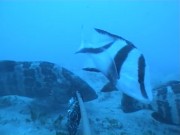
This very large study is part of the Seabed biodiversity study, published in Pitcher et al. (2007). Its purpose was to quantify patterns in seabed biodiversity and inter-reefal environmental conditions throughout the GBR.
This project will develop a Management Strategy Evaluation (MSE) framework to build understanding of the key human uses and drivers of change in the inshore Great Barrier Reef (GBR), and to inform GBR stakeholders of the likely consequences, costs and benefits of particular management decisions that aim to minimise the impacts on biodiversity, particularly from inshore multi-species fisheries.
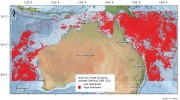
Climate change has emerged as the single greatest threat to coral reefs. The climate change threat will take many forms and includes projections that there will be higher abundances of coral diseases. Links have already been made between high temperatures and outbreaks of the disease ‘white syndrome’ in the Indo-Pacific but little is known about the disease due, in part, to not knowing where outbreaks will occur.
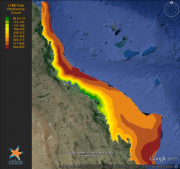
The purpose of this study is to detect and quantify spatial and temporal changes in reef fish assemblages of the Great Barrier Reef (GBR). Between 1993 and 2005, reef fish assemblages of 46 reefs were monitored annually along permanent transects within a standard habitat using visual census. The selected intensive survey reefs are distributed across three positions of the continental shelf and among six sectors each representing one band of latitude. These reefs continue to be surveyed in odd years as part of the Long Term Monitoring Program (LTMP).
This project focuses on relationships between socio-economic systems and the Great Barrier Reef (GBR). It comprises three interrelated activities to investigate:
1. Resident and tourist views about the relative ‘value’ of key ecosystem services that are provided by the reef. Researchers will design, distribute and analyse the results of a survey instrument to assess the relative value of different goods and services produced by the GBR to stakeholder groups using both traditional money-based valuation techniques and Larson’s non-monetary based technique.

This record details the TUMRAs that were in effect in 2009. Since then the number of TUMRAs has significantly increases. For the latest agreements refer to GBRMPA. A more recent version of this dataset is available on the eAtlas: https://eatlas.org.au/data/uuid/e180cca5-d652-4292-8272-69ac94977e6b
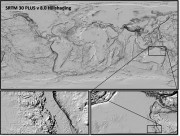
This dataset consists reprocessing and reformatting the SRTM30 PLUS v8.0 Digital Elevation Model (DEM) dataset developed by Scripps Institute Of Oceanography, University of California San Diego (UCSD) to produce a single raster covering the globe in GeoTiff format and create a full and low resolution hillshading from this DEM. The aim of this derived dataset is to reformat the data to allow easy use with GIS applications.
Full resolution hillshading:
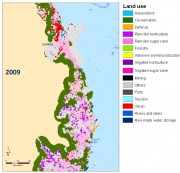
This dataset consist of inputs and intermediate results from the coastal scenario modelling. It is an analysis of the bio-physical factors that best explain the changes in QLUMP land use change between 1999 and 2009 along the Queensland coastal region for the classifications used in the future coastal modelling.
Methods:
The input layers (variables etc) were produced using a range of sources as shown in Table 1. Source datasets were edited to produce raster dataset at 50m resolution and reclassified to suit the needs for the analysis.

This dataset consists of rasters representing downscaled climate change scenarios (8 km resolution) for the Torres Strait and Papua New Guinea regions for 1990, 2055, 2090. This includes estimated mean surface relative humidity (%), wind speed, rainfall rate (mm per day) and surface temperature (degrees Celsius) estimated from simulated conditions for 1980?1999, 2046-2065 and 2080?2099 time periods. Also included is the relative change of each attribute with respect to 1990.
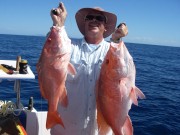
This dataset contains responses from line (n=53), charter (n=40), and trawl (n=21) fishers to a face-to-face survey about the impacts of the 2004 rezoning of the GBR on commercial fishing activity and commercial fishers.
Data Units:
Quantitative data about fishers attitudes, perceptions, and opinions about the 2004 zoning plan plus spatial data regarding pre- and post-rezoning locations used by fishers.
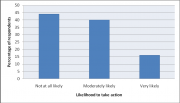
This dataset provides information about the Australian community's awareness, concern and actions regarding climate change and the GBR. It was aimed at providing a tool for developing effective engagement strategies and future climate change human dimensions research. The dataset contains data from 1,609 telephone surveys of people residing adjacent to the GBR and in the capital cities of Brisbane, Melbourne, and Sydney conducted in November 2008.
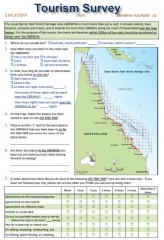
This dataset represents the aggregate of face to face surveys of 2743 visitors to the Great Barrier Reef World Heritage Area (GBRWHA) conducted in quarterly periods from June 2012 to June 2013. This survey was to explore how tourists feel towards and perceive Great Barrier Reef World Heritage Area, as well as their willingness to pay to protect the reef and their satisfaction with current and future developments in and around the GBRWHA.
The exposure of Great Barrier Reef coral reef and seagrass ecosystems to contaminants is estimated from the synthesis of: river discharge, water quality data sampled in inshore sites during flood conditions and the use of remote sensing technology to estimate flood plume extents and duration.
Our current knowledge of the mechanisms that affect diversity of plants and animals on the Great Barrier Reef (GBR) is minimal. This project will map the diversity of groups of organisms and environments of the GBR using existing long-term and large-scale data, and relate biotic diversity to spatial, environmental and temporal drivers. These relationships will be interpreted in the context of risk, zoning and management. Outcomes include:
1. Online interactive maps of the diversity of fishes, corals, other organisms and environments of the GBR.
The Reef Rescue Marine Monitoring Program (RRMMP) has identified that seagrass meadows along the Great Barrier Reef are in a state of decline. This project will undertake desktop analyses to quantify the exposure of seagrass meadows to flood plumes. Aquaria experiments will measure responses of seagrass to variation in light, nutrients and salinity. This project will also use use True Colour Remote sensing images, to derive flood plume exposure and relate to changes in seagrass abundance and composition.

This dataset corresponds to a database of datasets that are relevant for the development of coastal development scenarios and impact assessments GBR. It corresponds to a list of all the datasets that were sourced as part of project 9.4. It contains basic information about each dataset along with the license that each dataset was obtained under and where the data can be sourced. This database is an excellent starting point for any others looking at obtaining data relevant for coastal management.
Methods:
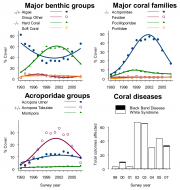
The purpose of this study is to detect and quantify spatial and temporal changes in benthic communities and juvenile coral assemblages of the Great Barrier Reef (GBR). Additionally, spatial and temporal variation in sources of coral mortality are monitored to assist with interpretation of changes in benthic assemblages. Between 1993 and 2005, benthic assemblages of 46 reefs were monitored annually along permanent transects within a standard habitat using underwater video/digital still photography.
The values of the Great Barrier Reef World Heritage Area (GBRWHA) are threatened by coastal development through habitat loss and runoff of sediment, nutrients and pollutants. Future coastal development is difficult to predict because it depends on volatile socio-economic and political factors. With this in mind, we developed a research project that uses spatially explicit scenario planning to identify plausible futures to 2035 for the GBRWHA coastal zone. The method used to produce maps of these scenarios is land-use change modelling using the GIS Idrisi.



